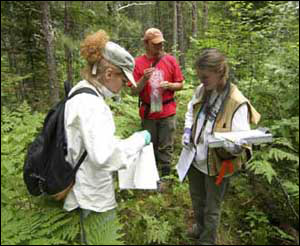Plant Program
The Plant Resources Program conducts surveys to identify quality habitat for plants and animals on the Leech Lake Reservation. We also map the locations of invasive species. We then work to protect, enhance, or restore these sites so that they may support traditionally important plants as well as rare and threatened species.

Photo above: Plant Resources staff conducting floral survey
Rare Plants
The Fish, Wildlife, and Plant Resources Department maintains a list of endangered, threatened, and sensitive species on the Leech Lake Reservation (link to Excel file: LLR TES List Jan.2007). As of January 2007, forty species of plants were listed. They include trees, orchids, ferns, and grasses. Habitats for the listed species include hardwood forests, coniferous forests, and bogs. The future existence of the listed species on the Leech Lake Reservation is mainly threatened by loss of suitable habitat. Activities that disturb or change the condition of soil, water, or sunlight in an area may result in conditions in which the current inhabitants of a site can no longer survive and reproduce.
To protect rare species, the Plant Resources Program conducts ecological surveys of sites that are proposed for home lease, timber harvest, or other ground-disturbing activity such as well or septic work. Recommendations are made based on the results of these surveys. We also collaborate with other agencies and educational institutions to monitor known populations of rare plants.
For example, we routinely survey for the rare goblin fern (Botrychium mormo). Because of serious threats to its habitat on the Reservation, LLDRM lists this species as Endangered. The goblin fern prefers old-growth sugar maple (Acer saccharum) forests, which normally have thick layers of leaf litter. Studies suggest that abundance of this species seriously declines in sites where leaf litter is absent and non-native earthworms are abundant. All earthworms in northern Minnesota today are non-native. When abundant, they can consume entire layers of leaf litter and dramatically change plant communities. The night crawler (Lumbricus terrestris), which is commonly used as fishing bait, has been identified as an especially threatening species. When anglers improperly discard unused earthworms, the worms move into the surrounding forest where they consume the leaf litter and threaten the sustainability of entire ecosystems.
 |
 |
Left Photo (by Amy Stewart): Goblin Fern (Botrychium mormo)
Right Photo (by Amy Stewart): Exotic Earthworm
Invasive Plants
Non-native plants can also seriously threaten entire ecosystems, so fighting invasive species is an important component of the Plant Resources Program. We use an integrated approach to manage noxious plants and non-native invasive species. Some species such as garlic mustard (Alliaria petiolata) are mechanically removed, whereas other species such as purple loosestrife (Lythrum salicaria) are controlled by leaf-feeding beetles. We also search for new invaders such as Eurasian milfoil (Myriophyllum spicatum) so that populations can be controlled before they become large. If uncontrolled, invasive plants can threaten culturally important resources such as sugar maple stands and wild rice (Zizania palustris) beds.
Integrated Resource Management
The Leech Lake Reservation includes land managed by various governmental and private entities. -Link to plant Resources Map- To protect and enhance the Reservation’s natural resources for the benefit of current and future generations of Ojibwe people, the Plant Resources Program participates in inter-agency and inter-departmental planning activities. For example, we represent LLBO at regional meetings of tribal, federal, state, county, and private landowners. These meetings are focused on developing methods of cooperation and integration of natural resource management throughout north-central Minnesota. The Plant Resources Program also conducts project reviews and provides comments to other agencies and departments on projects that may impact tribal interests such as traditional gathering or sustainable hunting and fishing. The Plant Resources Program is leading LLDRM efforts to finalize and implement an Integrated Resource Management Plan (IRMP) for the Leech Lake Band. This project includes compiling and updating draft documents and developing systems of communication and coordination within tribal entities. The aim of the IRMP is to insure that tribal decisions about land use and land management are made using all of the most current information available.
The Plant Resources Program also works with agencies such as the USDA Forest Service and Natural Resources Conservation Service on various projects. For example, we jointly conduct surveys for rare plants, combat invasive species, decommission roads, and restore native plant communities along roadsides and in wetlands.
Contact Us
DRM (218) 335-7400
| Name | Title | Phone |
| Mortensen, Steve | Fish, Wildlife & Plant Resources Program Director | 335-7421 |
| Kate Hagsten | Plant Program Manager | 335-7442 | Finn, Jon | Fish & Wildlife Field Specialist | 335-7424 |
| White, Gary | Assistant Hatchery Manager | 335-7424 |
| Robinson, Martin | Fish and Wildlife Technician | 335-7424 |
















 Division of Resource Management
Division of Resource Management